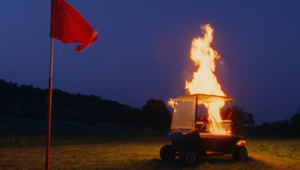
A Royal Mail Postie’s Day, Told through Their Hands

Royal Mail’s new campaign ‘In Good Hands’ created by Stink’s director Tom Green and AMV BBDO celebrates the hardworking postie we know and love, as a quintessential part of British culture, as well as the resilience with which they go through seasons, neighbourhoods and challenges.
The storytelling technique is a timeframe within a timeframe - the film follows the postie’s day from morning till night, but spans shots from across the year. But there’s a twist - not one face is seen in the entire film, as the campaign expands the meaning of ‘in good hands’ and only shows us the hands of the postman, as well as those taking their letters and packages.
Set to a commissioned poem by TS Eliot Prize-winning Roger Robinson and read by actor Sope Dirisu, the film’s background spoken word brings even more emotion to the viewer.
LBB’s Zoe Antonov spoke to director Tom Green to find out more about his beautiful storytelling, the poem behind the film and why diversity was so important in the campaign.
LBB> Tom, tell me about the brief of the film and how you tackled it at first?
Tom> I thought it was a really brave brief and I wanted to remain pure to the idea of telling the story only through hands.
I really liked what Tim Riley at AMV had written, and I wanted to convey the humanity of that and how much emotion you can get from hand gestures.
I don’t think I even had any faces in my treatment. Fundamentally, I wanted the film to have a really gentle quality that was not too fast paced, with a poetic and lyrical quality. Because I felt in that sense the film would represent what the brand could mean for the public. Like a reassuring picture of where it fits within British society.
To me, the clarity of the idea felt really cinematic, so I looked at filmmakers who have had a fascination with hands, like Nolan and Bresson, for inspiration.
LBB> The voiceover for the film is beautiful. What made Roger Robinson perfect for writing it and who spoke it? What message did you want to shine through in the script?
Tom> We always knew there would be a spoken word element to accompany the film - we worked with the poet Roger Robinson and the words were spoken to by the actor Sope Dirisu.
We discussed voices and casting, and felt that having a bespoke piece for the film was a nice idea… I think Rogers' words are actually really understated and beautiful.
We wanted it to have a sense of poeticism obviously but perhaps to not go over the top. We had to find the sweet spot that conveyed the right sense of how Royal Mail is part of the fabric of British culture. It feels like a slightly reassuring, more personal experience than perhaps some of its competitors. So it was important to find the right balance to portray that in the words. We ultimately wanted it to feel like it conveyed the relationship that posties have with their customers without it being overly sentimental. Rogers' words are beautifully considered and Sope’s delivery is perfect.
LBB> Did you film real people receiving their post or did you cast? How important was diversity and representation, regardless of the fact that you were only showing the hands of the characters?
Tom> We were really pleased with the casting of our lead postie who anchors the film - he gives it a beginning, middle and end, and he had a really nice performance to his hands that had a graceful quality and something that feels relatable too.
We worked with real employees of the Royal Mail so the film has a combination of actors and real posties.
It was interesting, we had two casting rounds. Initially I wanted to get a sense of the character behind the hands, so I looked at the actors’ performances as a whole, rather than just their hands. What I realised is that sometimes their hands and faces told two different stories, so I then moved the second part of the casting to focus more specifically on seeing how the hands worked and conveyed emotion, sense of storytelling, and sense of character. But we did use the voices of all of the actors and Royal Mail team in the film.
Diversity was paramount for everybody: myself, the client, agency and Stink. One of, if not the most important thing was to represent a cross-section of British society as well as the diverse workforce of the Royal Mail and we were very careful to make sure that that felt like a natural representation of both things.
The Royal Mail is one of the only brands that caters for the entire country so we tried to represent the length and breadth of the country too.
LBB> Tell me about the depicted locations and why they were important?
Tom> We tried to create a strong sense of different landscape changes, from urban areas to countryside and coastal - so you feel an environment change around the hands in each vignette.
LBB> Did you aim to show the work day cycle of a Royal Mail post person, starting from the morning and finishing in the evening? Or was there no time continuation you were aiming for, but rather a diverse shot list?
Tom> We had a storyboard and a strong sense of a narrative thread.
The film was always built around an idea of a year in a day. We had our lead character waking up, journeying through the various moments of the day, and he ends simply by tucking his baby in and going to bed. Within that we tried to create an elliptical sense of seasons changing through the year.
In terms of its timeline, it's a little bit of a timeframe within a timeframe. To convey the fact that posties are out in all weather conditions, all seasons.
LBB> What was the most challenging and equally the most fun part of working on this film?
Tom> There honestly weren't very many challenges. It was a lovely shoot. I loved working with Tim Riley again as I felt we had a great creative relationship making Guinness ‘The Purse’ together. In some ways it felt a little unusual to be focusing just on hands, but in a way, it allowed us to be really focused on the purity of the image and what’s happening in the moment.















